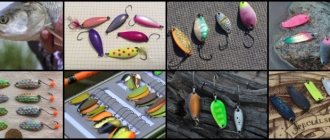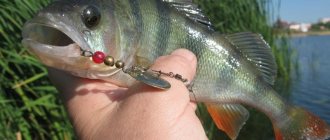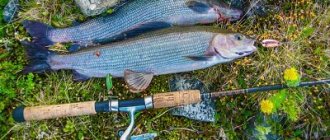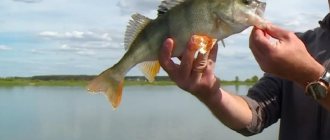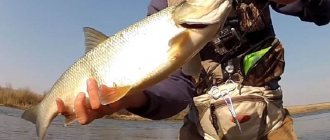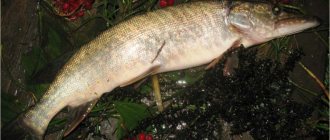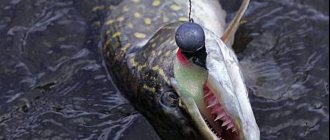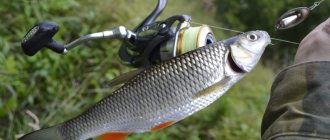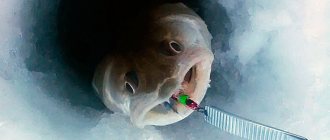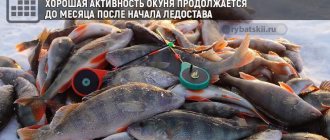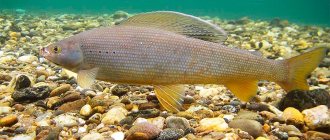Spinners
, or as anglers call them “spinners,” are one of the most popular artificial baits. The attractiveness of a spinner is that fishing with it does not require special skills and abilities from the angler. The wiring of the spinner is quite primitive, casting and reeling, which in turn allows the use of fairly simple and inexpensive spinning rods. Fish can be caught using “turntables” in all bodies of water and under almost any conditions. These conditions make the spinner especially popular among beginner spinners.
Content
- 1 General information 1.1 Efficiency of spinners
- 6.1 Perch fishing
- 7.1 Catching “white” predators
general information
Rotating spoons
Rotating spoons are among the most reliable and versatile baits for catching predatory fish in open water. They are effective both during periods of relative lack of biting and during active feeding, in almost all bodies of water where predatory fish live. Many anglers have a question: Why are spinners often more catchy than spinners? Although the latter are clearly copied from a living analogue, they look more natural and, in theory, should arouse much more interest in a predator than the incomprehensibly reminiscent, constantly flashing creations of technical progress.
A rotating spoon creates the same oscillatory circuit that attracts fish located at a considerable distance from the bait. Only the “rotators” become catchable, spreading vibration and fields around themselves that coincide with the bioelectric field of the escaping wounded fish. The predator detects the movement of such baits at a considerable distance within a radius of 5 to 20 meters and attacks fearlessly, ahead of competitors.
Spinner efficiency
The quality of a spinner can be judged by the presence of four main parameters:
- vibration that attracts fish during the rotation of the petal and the core equipment elements (the spoon sounds);
- magnetic field arising when the petal rotates;
- a game that attracts fish at different fishing intensities;
- the shape and coloring do not necessarily coincide with the live counterpart, but arouse increased interest in the predator in the lure.
In most rivers and reservoirs in central Russia, water transparency is very limited (within 0.8 meters), so the fish detects potential prey, primarily with the help of the lateral line organs, so rotating spoons have no competition.
Mepps Comet
At first, this model was offered as a spinner for trout fishing. But practice has shown that the spinner perfectly catches different types of fish, and, in particular, pike. When the bait rotates, vibrations occur, very similar to the trembling of a fish fleeing from a predator.
The spoon is painted with bright dots to imitate an insect. Almost all predatory fish feed on all kinds of insects before they start hunting for fry. Therefore, in the future, older individuals respond well to bait with this color.
Mepps Aglia Long
The most effective spinner for pike fishing, with all the necessary characteristics. The blade deflection angle is 60 degrees, which ensures stable play during slow retrieval. The model is designed for fishing at medium depths. This turntable has an affordable price and excellent quality.
If you are not familiar with our review of wobblers, I recommend that you look at it here - rating of wobblers for pike. The review included 12 of the most catchy minnows. Every experienced spinning player should know these wobblers :)
Author of the article: Vitaly Leonidovich Ivanov, 2021.
Classification
Spinner baits can be divided into four main types.
- The first type
is a standard spinner, in which the petal rotates around a rigid rod. Most of these baits have a core sinker under the blade, which gives the bait enough weight for long casting. - The second type
is front-loaded spoons, in which the sinker in the form of a head is located in front of the petal. - The third type
is spinnerbaits. Their rod looks like an open safety pin, with a sinker head and a hook located on the lower lever, and one or more rotating petals on the upper one. - The fourth type
is basebaits, which can take the form of either standard spinnerbaits with a sinker-core, or spinnerbaits, which differ only in that instead of a petal they are equipped with a special propeller.
According to the game, spinners can be divided into:
- “turntables with a narrow game”;
- “turntables with wide play”;
- rotating spoons with a fixed blade deflection angle.
Here, the angle of deflection of the petal when working from the rod is taken as the fundamental principle. Spinners with a deflection angle of up to 300 are considered “narrow game”, 55-700 are considered “wide game”. Many experts believe that spinners with a “narrow” action are more similar to the natural object of a predator’s hunt, but this is all subjective, and practice often proves otherwise. For example, the well-known Aglia long spinner from Mepps, with its long blade and wide action, is one of the most catchy spinners.
According to the loading option, rotating spoons can be divided into:
- Front-loaded
- spinners where the weight is located at the head end in front of the bow-clamp. Sometimes such a load is also called a head. - Back-loaded
- spinners where the sinker is located on the rod below the attachment point of the petal. This type of spinner is the most common. - Combined
(front-rear-loaded), often homemade spinners, when they sometimes try to increase the weight and therefore the flight properties of the bait, often to the detriment of its performance characteristics. - Unloaded spinners
- for fishing in the upper water horizon, such spinners are rare, but are not deprived of the right to exist, they have their advantages as surface “spinners” with good lifting force.
Review of the most effective spinners for pike
In addition, the blade deflection angle affects the working depth. For example, with a large angle of deflection of the petal, wiring is possible at the very bottom of the reservoir. Models with a smaller angle are designed for wiring at medium depths.
The amount and speed of rotation depends on the wiring itself. The higher the speed of the retrieve, the faster the bait rotates. But, as you know, pike does not like fast retrieves and prefers sluggish, easy prey. Before using the turntable, you need to make sure it is working.
The bait should begin to rotate from the first revolutions of the reel.
Structure of rotating spinners
The structure of rotating spoons A rotating spoon, as a rule, has the following main elements:
- Petal - a metal movable element rotating around the rod
- Rod - which is a metal wire that serves as a “frame” and has fastenings for a hook at the ends and an eye for attaching the bait. A weight, a core for weighting the spoon and a clamp are attached to the rod.
- The shackle-clamp is a very important link through which the petal is attached to the rod; the frequency of such a negative moment in a spinning spoon as “jamming of the petal” will depend on the correct shape and execution.
- The core (body) is an element strung on the rod, located between the petal and the place where the tee is attached, designed to weigh it down, which is important for casting, and also acts as a limiter for the petal. The core comes in various shapes (drops, cones, beads, tubes, etc.) the “narrow or wide” play of the bait partly depends on its shape, and the additional irritant (shiny, matte, etc.) depends on the coating option. There are various “delights” when the core can contain a reservoir for flavors, etc. Personally, I have not seen such spinners, I have only seen mentions of them.
- The sinker (loading) element, unlike the core, can consist of several parts and be located in front of the petal, the meaning speaks for itself - the weighting of the spoon.
- Hook - tee
- Spinning spoons are often equipped with swivels that prevent the line from twisting.
Selection of spinners
First you need to find out whether there is a current in the reservoir and what, at least approximately, is the depth at the intended fishing location. Based on these data, the type of bait is selected, that is, in our case, the shape of the petal, the size and weight of the spoon itself are selected. Remember - the higher the number of the spinner, the heavier it is. A very heavy spoon will plow the bottom and for this reason rotate poorly; in this case, the angler needs to change the bait to a smaller one. Sometimes it is enough to reduce the size by one, sometimes even by two numbers. Take, for example, a sandy beach. Many fishermen are familiar with this place. The bottom is slowly dropping. The depth at the release is rarely more than two and a half meters. The water is clear and there is no current. Sunny beautiful morning. The expected prey is perch and, if you're lucky, a medium-sized pike. There is no reason to rely on pike all the time, but catching perch is a task that is quite within the capabilities of even a novice spinning angler. Large heavy spoons, say Synchrony No. 4 or BCS No. 4, will plow the bottom. And they are too big for perch. In general, shore bass are not that big and a Synchrony #4 or BCS #4 will be overkill. But Synchrony No. 3, BCS No. 3 will be just right here. Perhaps even a “two” (No. 2) will help us out. Don't worry about the pike. The pike will eat both the “four” and the “three” and the “two” with great pleasure if it comes to the beach to check what the perches are doing so interestingly there. But large spoons may be too tough for perches.
Or here's another example. Medium river, current, the water is cloudy, the background depth is in the region of one to three meters. Mainly cloudy. Expected prey: perch, pike, asp and chub possible. Occasionally small pike perch. Here the Trait spinner will be the most optimal. Depending on the strength of the current, we can use both “one” and “two”. The first will allow you to fish the coastal zone, and the second will allow you to fish the area at the maximum distance. It all depends on the strength of the current, but these two sizes of Trait will become “magic wands”. The choice of Trait is all the more obvious if you take into account the lifting force of the current.
It is better to start with Trait number one, fishing primarily in the coastal zone. The fact is that by catching fish that have bitten from long distances, we risk scaring away the predators that are lurking near the shore. Therefore, you should always start fishing by fishing the coastal zone. And it doesn’t matter whether it’s a river, a lake or a pond without a current. The main thing is to start fishing correctly.
So, let's repeat. The bait is chosen optimally if it attracts fish with its game. It is necessary to choose the size and weight of the spoon suitable for the given fishing location. This means that the petal rotates well, and the mass allows you to move the spinner both at the very bottom, and in mid-water, and even at the surface, changing only the speed of rotation of the reel handle and the orientation of the rod relative to the spinner. At first glance, everything seems complicated. In fact, it couldn’t be simpler.
Turbines and propellers
Now let's talk about baits, which differ little from spinners. The impeller, or propeller, as it is also called (Fig. 26-25), is much smaller than the 00 rotator.
Such baits allow you to catch the most sporting perch. And if you fish with ultralight and want to enjoy a huge number of bites, but you are not interested in the fish as such - caught, released - then, of course, with such a bait it is much faster to score a perch than with any spinner.
What is the advantage of such baits? Thanks to the propeller, such a bait operates at any reeling speed, and no matter how we move it, it will rotate at a certain frequency. And it starts very easily.
Rice. 21-27 Turbines-propellers are good because they allow you to experiment quite extensively with the weight, because they work great on both very small and huge weights (Fig. 26-27). The ratio of its characteristics and the size of the propeller and the weight of the weight and the size ratio are not as critical here as on rear-loaded turntables. Such mini-baits are excellent for catching perch; in fact, in any low-biting situation it is possible to catch fish with them.
Rice. 21-26 It is very interesting to use double propellers (Fig. 26-28). This bait has the same propeller as the second one, only there it is slightly bent in order to make it compact, but here it is actually straight. This does not affect the working qualities, and it is necessary to bend the propeller only to make the bait extremely compact. When moving, the propeller rotates at enormous speed and is virtually invisible. So, the fish does not actually notice the propeller, but mostly attacks the body of the bait.
This bait with two propellers is also very good for catching perch, because it has double vibration. The trick of this bait is that the propellers rotate in different directions - thereby we manage to avoid the line from twisting. Lures assembled on the basis of turbine propellers are the most compact. In addition, it is much more difficult to make a working, high-quality spinner with a blade of 00, 000, 0000 than a minimum-sized bait based on a propeller or turbine. It goes without saying that these baits also have their drawbacks.
And their main drawback is that when retrieving, they pull the line very weakly, i.e. The line is wound onto the reel with very little tension. As a result, when fishing with such baits, beards and dropped loops often occur, due to the fact that the line is not tensioned as much as when fishing with rear-loaded or front-loaded spinners. Moscow, of course, is not the best place for fishing, but it is a good place to spend time. Every seven days we conduct river cruises from Moscow. If you have a woman and she loves romance, then a cruise for two is the best solution! Another disadvantage is the casting range. When casting, the propeller rotates, which affects the casting distance. But if we fish with ultralight, the casting distance is not so critical. Based on this, it is possible to say that this bait works and catches perch perfectly.
Homemade spinner, turbine, spinner, Devon Spoon killer of perch, rudd, roach with your own hands
Advantages of spinners
Rotating spoons also have advantages over jig baits and wobblers that will keep them in fishermen’s boxes forever. Their ease of use is worth it. What could be simpler - twist the reel handle, and the spinner will do the rest itself. Of course, in experienced hands, with uneven wiring with short pauses and an uneven pace, the result will be much higher. But even a complete beginner, unfamiliar with the intricacies of wiring, will be able to catch his fish on a spinner. Let's compare this situation with wobblers. To learn how to properly guide a wobbler you need to spend a lot of time and effort. And this is only for one type of wobbler. It is no secret that each type of wobbler requires its own individual approach to the wiring method, and to be completely honest, it would be more correct to say that each individual wobbler model is purely individual and requires the same attitude.
In terms of price, spinners are much more affordable than wobblers and jig baits. And when it comes to quality, they are not far behind them. Especially modern models from well-known manufacturers. The leaders in this industry are, of course, Japanese companies; their lures are a real work of art. The Americans and the French are also not far behind, their models are respected by spinning experts, and they are much more affordable in price than the Japanese ones.
Rotating spoons work great even with inexpensive monofilaments, which are completely unsuitable for fishing with wobblers and jig fishing because of their stretchability. The big advantage of turntables is their increased resistance to wiring. Maintaining a constant line tension has a positive effect on the sensitivity of the wiring, the bait is quite easy to control. A good tension allows the line to lay smoothly, without loops, on the reel spool. Agree, this is also an important advantage - you don’t have to waste time and nerves on untangling your beard.
But the most important advantage of rotating spoons remains those, unique to any bait, high-frequency vibrations created by the rotation of the petal. It is these vibrations that can interest a predator; he hears and feels them from a very long distance. It is not yet completely clear what makes a predator look for the source of these fluctuations and attack it. After all, the rotating spoon does not imitate any underwater inhabitants or any food object in its appearance and its play. But the fact remains that the pinwheel copes with its task perfectly - it causes aggression in the predator and provokes it to attack.
Structurally, all spinners are similar to each other, but, of course, there are differences. They vary in petal shape, size and weight, and color. Differences in shapes have been refined over the years to suit a certain type of predator, different fishing conditions and even different weather conditions.
Summer spinners
Read more
Among the types of spinners there are rotating and oscillating baits, devons, unhooked baits and bladebaits.
Summer fishing is unique every time due to changing weather conditions, the characteristics of the reservoir and the equipment used for fishing. The choice of bait plays an important role in getting a good catch. Numerous reviews of spinners and a wide variety of their types allow the fisherman to create an individual set of the most catchy and easy to use.
Types of bait
An experienced fisherman knows that buying a spinner and a spinner is not enough to guarantee a catch. You should also have other types of bait in your backpack - the most catchy one in the conditions of a particular reservoir will be selected on the spot.
Spinner
It began to be used about a hundred years ago to attract as many fish as possible in the area where the spoon was cast. Today the choice of spinners (spinners) is very large, you can buy a Ponton 21 or Kuusamo spinner, St. Petersburg or Finnish spinners. The spinner is a metal rod equipped with an eyelet at one end for attaching a fishing line, and a hook at the other. A petal is attached to the hinged rod, which rotates during wiring. Typically the petal is made of metal. The principle of catching pike with a spoon and other predators is to create water vibrations and noise around you. The petal, as well as the core, come in different configurations, which determines the characteristics of the gear’s operation. Almost all predatory fish bite on the spinner.
Oscillating spoon
Traditionally used for pike perch and other predatory fish. It is a metal plate with smooth lines of death. Usually its appearance imitates the small prey of a predator. In the water column, when guiding, the play of the spinner resembles the movements of a fish - it waddles and dives, prowling and slightly changing the angle in relation to the trajectory of movement. An oscillating bait, if, for example, you buy a Blue Fox spinner, when the sun hits its polished metal side, it glitters, attracting the attention of a predator. After rains and in muddy, peaty water, tackle in brighter colors is used.
Devonian
Fishing for Devon in terms of the technique of attracting fish is reminiscent of fishing with a spinner. Devons, according to some anglers, the best lures for pike, are equipped with wings or a propeller that make its smooth cylindrical body rotate. Hunting with bait can be especially effective in muddy water. The disadvantages of the gear include the difficulty of guiding in thickets. The complex design of the bait causes the line to twist around the core. But there are fishing enthusiasts who are ready to buy a Devon spinner, considering them to be the most effective.
Cicada or bladebait
Another noisy spinner for perch and pike perch, which is a metal plate with a weighted suspension. In the central part, the plate has several holes through which the fishing line is attached. By changing the center of gravity, the fisherman increases or decreases the noise of the bait and the force of its vibrations. Bladebaits, like Devons and spoons of various configurations, are effective when catching pike, pike-perch, and perch. Other types of summer lures
Fishing is a pleasure and one of the sports. It’s not enough to buy a Meps spinner spoon - you need to learn how to use the bait correctly. Fishing requires good knowledge of the habits of the inhabitants of reservoirs, observation and, of course, skills in using gear. For fishing on a bank overgrown with water lilies, a non-hooking spoon with antennae is effective. They are mobile and cover the sting of the hook, preventing it from clinging to plant stems. Small fish, including perch and roach, can be attracted to fly spoons - a miniature bait available in a wide variety of body configurations and types of attachment to the fishing line.
Fishing with spinners
Fishing with spinners With a spinner, everything is simple: cast it and reel it in.
These are one of the few baits that allow you to fish without problems with inexpensive monofilament lines, the stretchability of which can completely “kill” the jerking action of a wobbler or the sensitivity in jig fishing. During retrieving, the “spinners” create noticeable resistance to forward movement, and the more the spinner “rests”, the more the line is stretched and its excess slack is taken out. This allows you to have good control over the movement of the spinner, which is an undeniable plus for beginners. The line with a rotating spinner lies on the spool of even a cheap spinning reel very tightly and evenly, practically eliminating the formation of unexpected “loops” and “beards”, the untangling of which does not require wasting precious fishing time.
You can manage not to catch a fish with a rotating spoon only in winter and late autumn, when the predator is not very attracted to the high-frequency vibrations generated by the rapidly spinning blade. This noise effect is specific to the design of the bait itself. Any fish notices the vibrations of the bait from a fairly long distance, which is very useful when searching for predator sites on any large or unfamiliar body of water.
A spinning spoon becomes a very good reconnaissance bait that is worth setting out and checking first. In terms of its effect on a predator, the “spinner” is an irritant that has little in common with the fish’s real food items, but almost always provokes an aggressive attack.
Perch fishing
Perch is an active predator that responds well to noisy and high-frequency baits. It is very easy to catch it with rotating lures; you just need to find a school of “striped fish” feeding at half-water or on top, when it gives itself away with a characteristic fight, accompanied by slurping. Casting into such a “cauldron” and retrieving the spinner at a leisurely, slightly “ragged” pace works flawlessly in such cases. The larger single perch also readily takes the “spinner,” preferring to stay apart under shallow dumps, along tracts of grass and reed walls.
The most outstanding “spinner” catches of perch occur in June - August, but not in the most intense heat. For perch, a not very large spoon is suitable, with a petal 2-4 cm long and weighing 4-8 g. The petal of heavier baits rotates more slowly, so the spoon does not hold the horizon well during slow perch fishing. The predator always responds well to the most noisy baits, with various acoustic holes or a bell core.
The best spinners are Mepps Aglia Long No. 1+, Mepps Aglia No. 2, Blue Fox Vibrax No. 3 and No. 4. For long-distance and accurate casting, the 8-gram Smith Niakis is well suited.
Pike fishing
This classic spinning fish involves classic spinning fishing with classic spinning lures: rotating and oscillating spoons. Pike responds well to the “spinner” throughout the warm season. Only in late autumn, with a sharp cooling of the water, does it begin to give a clear preference to slow, imposing oscillating spinners, which have an undeniable advantage even in thick grass in a non-clinging version, but in open places when fishing “in areas” for numerous grass pike, the “spinners” break out again forward.
For coastal pike, larger baits are ideal, with a wide blade (sometimes two) 4-7 cm long, with a leisurely and not very intense rotation when retrieved at a slow pace. The mass of spinners should be selected as minimal as possible for specific fishing conditions. In some cases (shallow water or a carpet of grass), baits without any weight at all work ideally, for example Mepps Lusox with an unfastened weight head. You can drive the “spinner” almost to the point of stopping the rotation of the petal. Pike loves this technique. She “hears” the spinner from a considerable distance and rushes to attack even from a distance of 20-25 m, which is sometimes visible from the surface keel wave in shallow water bodies.
The following spinners can be considered trustworthy in pike fishing: Mepps Long No. 3-4, Mepps Lusox No. 2-3, Blue Fox Vibrax No. 3-4, Rooster Tail U2 oz, large Rooster Tail Lite with a wide blade. They are excellent for catching small and medium-sized pike, which stay in relatively shallow areas of reservoirs. Trophy fish require slightly different baits.
Dimensions of a spinner for pike
Models No. 1-4 are aimed at catching pike specifically. It is also possible to use smaller baits, but they will not provide a large catch (except perhaps in the spring).
The shape of the petal is directly related to the angle of its deflection. The best spinners for pike fishing are lures with a round or oval petal shape. This allows the lobe to deviate over long distances, which will give the bait greater volume. Pinwheels with a petal shaped like a willow leaf have a smaller deflection angle, and therefore attract predators less.
Related article: catchable wobblers for pike
Fishing for pike perch
Pike perch is a true inhabitant of the depths. To catch it, rotating spoons of a slightly different design are used, although they have a lot in common with a regular spinner. A deep spinner practically consists of a classic spinner that does not have its own weight and a sinker attached to the front ring of the spinner. The hook on this spoon is a regular tee, only larger than a regular one. Some kind of plumage is tied to the tee, usually a brush of artificial hair or something similar. The plumage serves as a kind of stabilizer that keeps the spoon suspended, thus promoting the unwinding and stable rotation of the petal, especially when the spoon is in free fall.
It is worth noting here that for deep spinners they use only stepped wiring, with stops for free fall, right up to the spoon touching the bottom. During free soaring, the rotation of the petal should not stop. The most suitable retrieve is considered to be a smooth, slow, step-by-step retrieve - three or four leisurely turns of the reel and stopping until the lure touches the bottom. A pike perch bite can occur at any moment, both at the moment the bait moves and at the moment of free fall.
Catching "white" predators
Catching so-called “white” predators (ide, chub and asp) is a very promising area for using rotating spoons. They are perfect for each other in every way.
Fishing on small rivers and forest streams is usually associated with chub, where small “spinners” (from No. 00 to No. 2) of variegated colors always perform well, carried out in the upper layers of the water, near branches or bushes of underwater vegetation hanging over the water. For this fish, what is primarily important is the effect of the sudden appearance of bait in its field of vision. The spoon should either unexpectedly fall to the chub guarding its prey literally “from the sky”, or fly up to it in a seething stream of riffles. The fish itself always stays in the quiet of the stream, hiding behind natural obstacles to the flow of water. Ide is caught with spoons in deep water: in clean lakes or large rivers. There are several nuances in ulcer fishing.
First of all, in the wiring of the blade “turntable” there must be malfunctions in the operation of the petal: micropauses in uniform rotation. The ide sometimes accompanies the bait for a long time, and the bite is decided just after such an artificial failure of the game. Another important detail is the concentration of the fish’s attention on the tee of the spoon. Usually, flies and lurex tassels are used for this; simply gold-plated hooks also work well. The flickering of a shiny tee or the movement of a motley fly causes an ide to bite.
Lures can be quite large and heavy, for example Myran Panter or Agat 15-18 g, Mepps Heavy Long No. 2. For asp, casting range comes to the fore. He is not very demanding when it comes to playing bait. The main thing is to get the fish to the site. Thin fishing line and a decent weight of the spoon are the main parameters in this task. Not so many truly heavy baits have been created, since manufacturers have to solve the problem of stability of the petal when increasing the mass of the spinner core above the usual average values. Only a few manage to solve it.
The favorites are the same Myran lures, which have proven themselves in catching ide, Heavy Long No. 3, 12-gram Smith Niakis and a 17-gram modification of the Daiwa Silver Creek spinner. Rotating spoons remain indispensable in trout fishing, and still do not lose ground in the sport of fishing. They continue to bring victories and pick up the keys to the most capricious fish. “Spinners” have forever entered the arsenal of spinning rods and are not inferior to even the most sophisticated new products on the fishing lure market. This is why we believe in them.
Turntable wiring
Wiring a rotating spinner
There are not so many wires for a regular spinner. Throw and pull, or pull with pauses. Everything else is minor nuances that are unique to each angler.
Manufacturing of spinners
For this job we will need certain tools. Their set is minimal and has no pretensions to special sophistication, but they are sure to be found in every fisherman’s arsenal:
- Tailor's or metal scissors;
- A teaspoon, preferably deep;
- Hammer;
- Punches made from hard wood (beech, oak). The size at the base of the punch is 14x14mm and should be slightly rounded;
- The substrate and preferably massive. For maximum ease of use, you can solder it into a jar of lead;
- Hand drill;
- Drill d=1.2-1.3mm;
- Material for plaster (sandpaper of varying degrees of grain, pieces of felt or felt, GOI paste);
- Wire cutters;
- Kern;
- Round nose pliers;
- Pliers;
- Soldering iron;
- The file is flat, numbered 2 and 3.
We use an ordinary deep teaspoon as a matrix. A weight weighing up to 20 g (dimensions 26x15x5 mm) is cast according to a model in a plaster mold; the model is made of wood.
To make a spinner, you will need any fairly soft material - copper, brass, soft stainless steel, cupronickel. Its thickness should be 0.5 mm (the thinner the better). We use steel wire d=0.7 mm as a rod.
Using a template made in advance, we cut out the workpiece and polish it on both sides. Then we place the workpiece in a spoon, and with gentle blows with a hammer we give the future lure the desired shape.
Drill a hole 2-3 mm from the edge. Using pliers, bend the drilled side of the spoon at a right angle. The petal for the spinner is ready. Now let's start installation.
To avoid blades of grass getting caught in the cracks, we attach the tee to the wire of the rod. The winding ring will not impair the performance of the spinner. Using round-nose pliers, we construct a loop at the end of the wire, where we insert a tee, and wrap the free end around the core wire. We cut off all excess with wire cutters.
We wrap the core wire of our spinner with copper wire. This is a limiter. We string beads and the petal of the spinner. Let's adjust our lure with a limiter so that it does not reach the eyelet of the 5 mm hook. Solder the copper wire.
We mask the tee with red woolen threads or goat hair. The spinner is ready. Now it's time to try it out.
Simple surface bait with two propellers (Buzzbait)
Greetings to all lovers of crafting, I offer for your consideration instructions for making an interesting Buzzbait bait, intended for surface wiring. When pulled, the bait makes a lot of noise, splashes, water literally, of course, all this attracts pike and other predators. You can fish with such gear in reservoirs with underwater vegetation, snags, and so on. Everything is assembled simply, and it works perfectly. If the homemade product interests you, I suggest you study it in more detail!Materials and tools used by the author:
List of materials:
— sheet aluminum or other metal;
- stainless steel wire (or knitting needle); - beads; - weight; - thin elastic bands; - winding ring and hooks. List of tools:
- round nose pliers and pliers; - paper, pencil, scissors; - needle files; - stationery knife; - flat-head screwdriver, hammer; - paint (optional). Homemade manufacturing process:
Step one. Propeller manufacturing
First of all, let's make templates from paper, fold the paper like the author and draw the profile of future propellers. Well, then all that remains is to cut out the same parts from metal. If you choose sheet aluminum, you can cut it with metal scissors; this also applies to copper.
Step two. Preparing the weight and axle
The author decided to paint the weight, but it is not necessary to do this, because the eye will react to noise and is unlikely to consider the color. You can use a rigid stainless wire or knitting needle as an axis. We install the weight and bend the wire like the author, now the weight will not go anywhere.
We install the propellers on the axle, using beads as stops. With this installation, the propellers will rotate very easily. We knit a loop at the end of the wire.
Step four. Tail and completion
It would not be superfluous to make a tail for homemade work; it is attached to the part where the weight is located. As a result, when pulled, the backside will sink and the nose will rise. The author made the tail from rubber bands; right there in the tail there is a loop for installing a hook. If desired, you can install a single hook, double or tee; winding rings will help you with this. The homemade product is ready, you can test it, everything works perfectly, as the author intended. This completes the project, I hope you liked the homemade product and found useful thoughts for yourself. Good luck and creative inspiration if you decide to do this again. Don't forget to share your ideas and crafts with us! Source
Become the author of the site, publish your own articles, descriptions of homemade products and pay for the text. Read more here.
